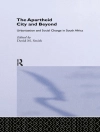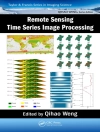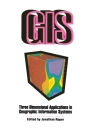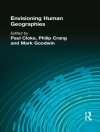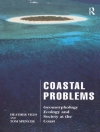This book explores how to tackle the challenges of urbanization through international lessons in sustainable development and smart growth strategies. As readers will discover, smart growth offers an approach to urbanization with the aim to: improve the efficiency of land use, protect the natural and cultural environment, promote economic prosperity and improve the quality of life. Authors address various challenges experienced in China, including deepening regional imbalances, an aging population, wholesale environmental degradation and traffic congestion. China’s official long-term urbanization plan sets many challenges for urban planners, these range from implementation of the plan and financing, to protection of vulnerable groups and social justice. This book brings readers up to date on the use of big data and modern technologies such as geographic information system technology (GIS). The work encompasses themes of environmental planning, community development, cultural heritage preservation, land use and transportation, urban studies, climate change, housing and community development, infrastructure planning, disaster planning and social equity. Authors present the very latest theories and practices of smart growth and offer many valuable insights to urban planners and scholars, as well as policy makers.
สารบัญ
Chapter 1. The “Historical Structure” of Urban Form: Characteristics, Evolution and Significance—The Case of Chengdu in China (Li Xu).- Chapter 2. The China Paradox of Migrant Labor Shortage Amidst Surplus Rural Laborers: an Alternative View (Chen Chen).- Chapter 3. Big Theory for Complex World: Integrating East and West (Shih-Kung Lai).- Chapter 4. From Polysemous Affect To City Integration: The Definition Thinking and Frontier Method to Radiation Realm of City Rail Transit Station (Dongzhu Chu).- Chapter 5. The Optimizing Strategies of Three-dimensional Walking System in Mountainous Citie: Take Chongqing Yuzhong District for Example (Ling Huang).- Chapter 6. Study on Urban Spatial Structure in the Perspective of Jobs Housing Balance: a Case of Suzhou, China (Zhenlong Zhang).- Chapter 7. Research on the Feasibility and Suitability of a Traditional Community Turning into an Elderly-livable Community: An Investig
ation of Tanhualin Community in Wuhan (Liang Guo).- Chapter 8. Analysis on Spatial Impact Factors of Poverty and Its Planning Suggestions: A Case Study of Guizhou Counties (Zhengxu Zhou).- Chapter 9. Big Data and Urban Traffic Management (Jia Chen).- Chapter 10. Research for Increasing FCD Map Matching Accuracy Based on Feature Extraction of Continuous Traffic Flow and Interrupted Traffic Flow (Zhiping Zhang).- Chapter 11. Green Transportation Planning Strategy of Mountain city - A Case of Anshun City, Guizhou (Jia Chen).- Chapter 12. Visual Impact Analysis and Control Method of Building Height for Landscape Preservation of the Traditional Gardens: A Case Study on Landscape Preservation of the Suizen-ji Jōju-en in Kumamoto City (Li Lin).- Chapter 13. Satisfaction Level of Elderly People’s Life in Urban Communities Based on the Status of Internet Usage — A Survey Covering Different Types of Communities in Xi’an (Liuchangyue Li).- Chapter 14. Study on Characteristics and Policy Recommendations of Small Towns in the View of Regional Development Strategy in Coastal Area of Jiangsu Province, China (Shuping Cui).- Chapter 15. Space Design of Slow Mode Transportation System of Mountainous City (Yong Huang).- Chapter 16. Participatory Governance and Challenges of Situated Informalities in the Developing Countries (Md Masud Parves Rana).- Chapter 17. Combined Commuting Mode For Residents In Big Cities By Healthy View – A Case study of Xi’an ( Zirui Lyu). - Chapter 18. Problem Analysis of Urban-rural Industrial Land Use in the Metropolitan Areas under the New Urbanization Policy—The Case Study of Shanghai (Fan Yang).- Chapter 19. The Urban Design Strategy of Chongqing Special Steel Industrial Site in the Process of Rapid Urbanization (Qi Zhang).- Chapter 20. Following Natural Features—The Planning Method Research on Spatial Arrangement of Blue-Green Web Around Urban Core Area (Zhong Xing).- Chapter 21. A Comparative Study on the Evolution of Greenbelts in London and Beijing (Mingfei Ma).- Chapter 22. Land Smart Growth and Sustainable Development: A Study of Implementation-based Innovational Country Unit Planning in Shanghai (Jianqing Lai).- Chapter 23. Urban Spatial Cultural Structure Analysis: Based on the Empirical Study on Shanghai Xintiandi and Chongqing Xintiandi (Ling Hunag).- Chapter 24. From Margin to Center: Study on Central City Development Strategy in Qinling-Bashan Hinterland Areas (Qi Yu).เกี่ยวกับผู้แต่ง
Qisheng Pan is a Professor and Chair in the Department of Urban Planning and Environmental Policy at Texas Southern University. Dr. Pan received a Ph.D. in Urban Planning from the University of Southern California (USC) in 2003 and a Master’s degree in Computer Science from USC in 2001. He also held a Master’s degree in Cartography and Remote Sensing and a BS in Geology from Peking University. Dr. Pan’s research focuses on multiple aspects of urban planning, including transportation planning, economic impact analysis, and the applications of GIS in urban planning. He has received research grants from Texas Department of Transportation (TXDOT) to measure access to public transit services and to examine port-related traffic and emissions. He has also studied on the economic impacts of terrorist attacks on Central Business Districts and infrastructures in large metropolitan areas. Recently he received the Natural Resources Imagery Grant from ESRI to utilize SAR imagery technology in pipeline integrity management. Dr. Pan has consulted in multiple research projects from National Science Foundation’s Digital Government Program and Department of Homeland Security. Dr. Pan is serving as the Chair of the Board of Directors (BOD) for the International Association for China Planning (IACP), 2013-2015.
Weifeng Li is an Assistant Professor in the Department of Urban Planning and Design at the University of Hong Kong. Dr. Li received his Ph.D. in Urban and Regional Planning from Massachusetts Institute of Technology (MIT). He also holds both a Master’s degree and a bachelor’s degree in Geography from Peking University, China. His research interests focus on environmental sustainability, urbanization and environmental changes, land use-transportation planning interactions and the environmental and energy impacts, as well as the use of GIS and spatial analysis in urban planning. Currently he is working on neighborhood design and energy efficiency fu
nded by Research Grants Committee in Hong Kong and built environment and air quality funded by NSF of China. Dr. Li is a board member of the International Association for China Planning (IACP), 2013-2017.


